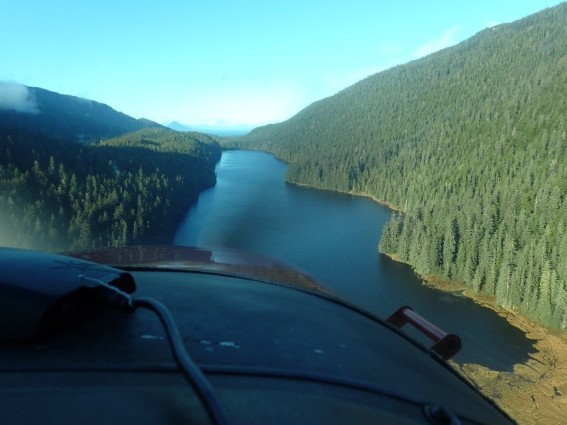By Mike Hodges, Air Safety Investigator, NTSB Office of Aviation Safety
On August 9, 2008, a privately-owned Cessna 182E airplane was reported overdue near Juneau, Alaska. The NTSB immediately started monitoring search efforts being conducted by the US Coast Guard, the Alaska State Troopers, the Civil Air Patrol, and a host of good Samaritans. The search area was expansive and included remote inland fjords, coastal waterways, and steep mountainous terrain. In an effort to start gathering information that was potentially relevant to the accident, we interviewed other pilots flying in the area, as well as Federal Aviation Administration (FAA) Flight Service Station personnel to better understand weather conditions at the time the airplane disappeared. After an extensive but unsuccessful search, search-and-rescue activities were suspended on August 20, 2008.
For all aviation accidents such as this one, when initial search-and-rescue activities are suspended and no wreckage is found, the NTSB issues a preliminary report, available to the public in an aviation accident database that can be accessed through our website. If the wreckage is not located within 180 days from the initial date of disappearance, we complete a final report with a probable cause statement of “undetermined.” The final report includes all pertinent information that was initially gathered at the time the aircraft was reported missing. If the wreckage is eventually located after the initial 180 days, we reopen and complete the investigation.
On October 25, 2017, I was the on-call air safety investigator for the NTSB Alaska Regional Office. Alaska State Troopers notified me that a deer hunter had discovered airplane wreckage on Admiralty Island, about 15 miles south of Juneau, Alaska. We eventually determined that it was the missing Cessna 182E. So, 9 years after the airplane went missing, we reopened the case.
In Juneau, I met with an aviation safety inspector from the FAA, an Alaska State Trooper, and members of Juneau Mountain Rescue. As with most remote aircraft accidents in Alaska, traveling to the scene requires an airplane or helicopter because there are no roads. The NTSB chartered a commercial, float-equipped Cessna 206 airplane, and we flew to Young Lake on Admiralty Island in the Tongass National Forest—the largest intact temperate rainforest in the world.

As an air safety investigator working in Alaska, I often face unique challenges, whether it’s a hike to a remote area to reach an accident site or a wildlife encounter. In this case, after arriving at the northern end of Young Lake, we hiked nearly 2 miles to the accident site, each of us carrying either firearms or bear spray because of the large population of brown bears on the island. We also carried satellite phones because there’s no cell phone reception in the area. The wreckage was in densely‑forested, steep mountainous terrain a little over a mile northwest of the north end of Young Lake, at an elevation of about 1,075 ft. mean sea level. The average tree height at the accident site was about 100 ft.

When we arrived at the site, the FAA aviation safety inspector and I documented and examined the wreckage. The cockpit and fuselage were destroyed by a postimpact fire. The wreckage of the missing airplane was confirmed via the serial number located on the airframe data plate. Time and nature had taken their toll—the heavily corroded wreckage was covered with dirt, fungus, leaves, and branches. The Alaska State Trooper recovered the remains of the two occupants.

Once the investigative and recovery activities were completed, we hiked back to Young Lake, contacted the commercial aviation operator for pickup, and returned to Juneau. Because the location was so remote, the wreckage was not recovered.

On-scene activity is just one part of our investigative process. In each investigation, we look at the roles of the human, the machine, and the environment. By learning about the factors that cause an accident, we can make recommendations to prevent similar accidents in the future. In this investigation, I reviewed the airplane’s maintenance records, considered the pilot’s aviation training and medical records, and examined meteorological and topographical data for the accident area. As a result of the investigation, the NTSB determined that the probable cause of the accident was the pilot’s decision to continue visual flight into an area of instrument meteorological conditions, which resulted in the pilot experiencing a loss of visual reference and subsequent controlled flight into terrain. The pilot’s self‑induced pressure to complete the flight also contributed to the crash. The final accident report can be viewed here.
If you ever happen to come across aircraft wreckage—or what you think is aircraft wreckage—no matter how old it appears to be, please notify local law enforcement and the NTSB Response Operations Center in Washington, DC. If you’re able, please provide latitude and longitude coordinates of the wreckage location, along with photographs of what you found. The NTSB can then continue investigating what happened, which can help prevent future accidents from occurring. Also, importantly, family and friends of those who died in the accident may be interested in the new information. If you ever have the chance to visit the NTSB Training Center in Ashburn, Virginia, you will see an etched window on the front of the building that states the building is dedicated to the victims of transportation accidents and their families. The display also summarizes the NTSB’s crucial work of improving transportation safety for our great nation: “from tragedy we draw knowledge to improve the safety of us all.”



 jacket they see at accident scenes. What’s less well known is that examining and documenting on-scene evidence is just one step in an exhaustive process to gather all available information, determine a cause, and recommend any changes that can prevent similar accidents.
jacket they see at accident scenes. What’s less well known is that examining and documenting on-scene evidence is just one step in an exhaustive process to gather all available information, determine a cause, and recommend any changes that can prevent similar accidents.





